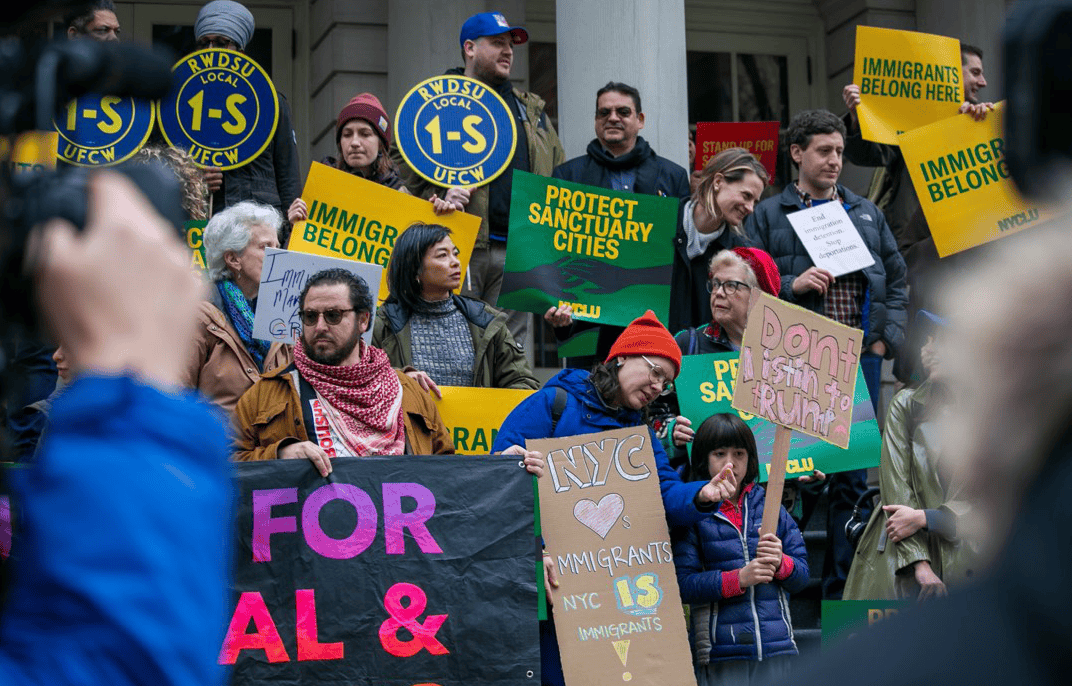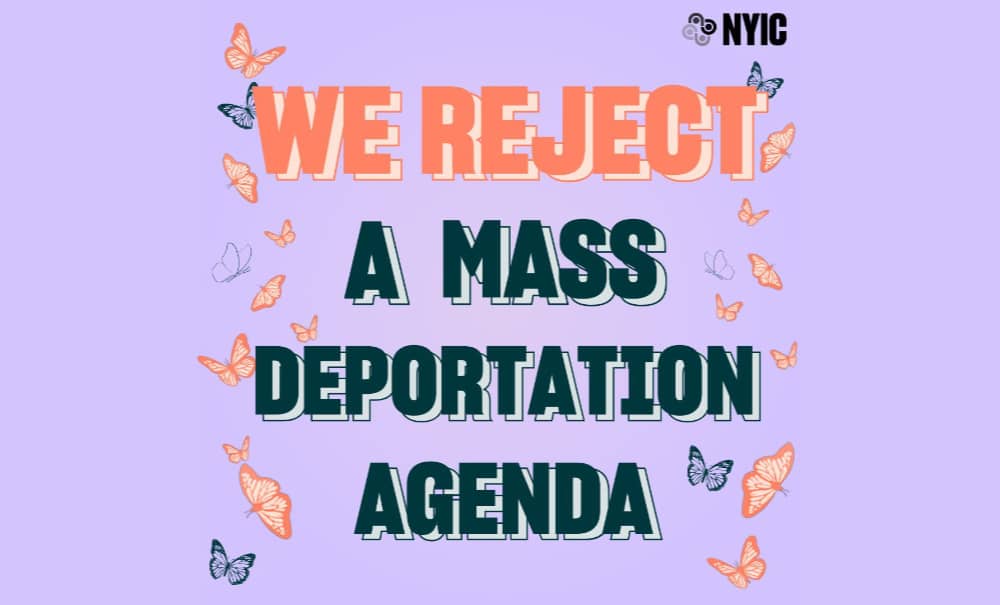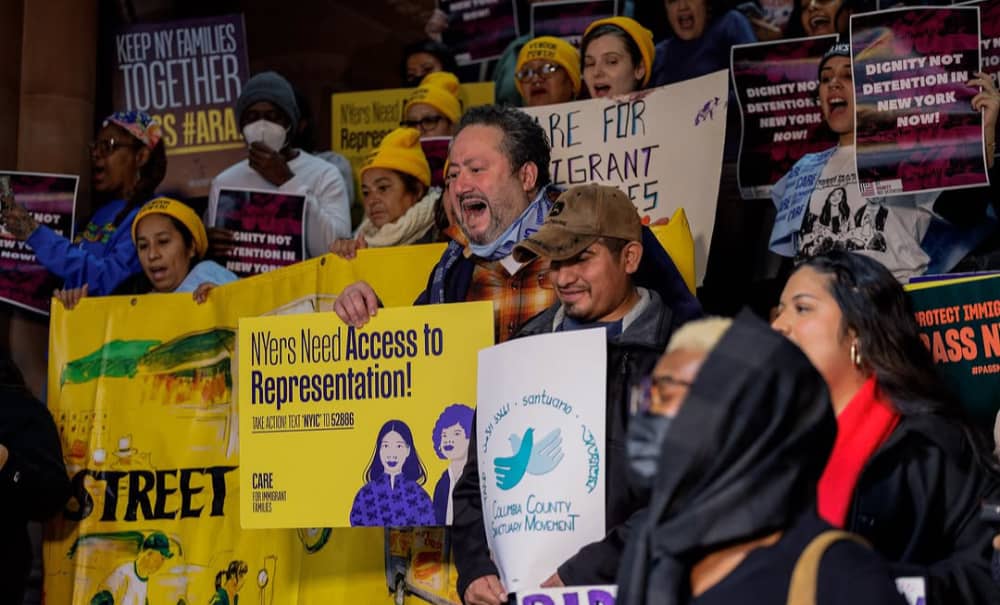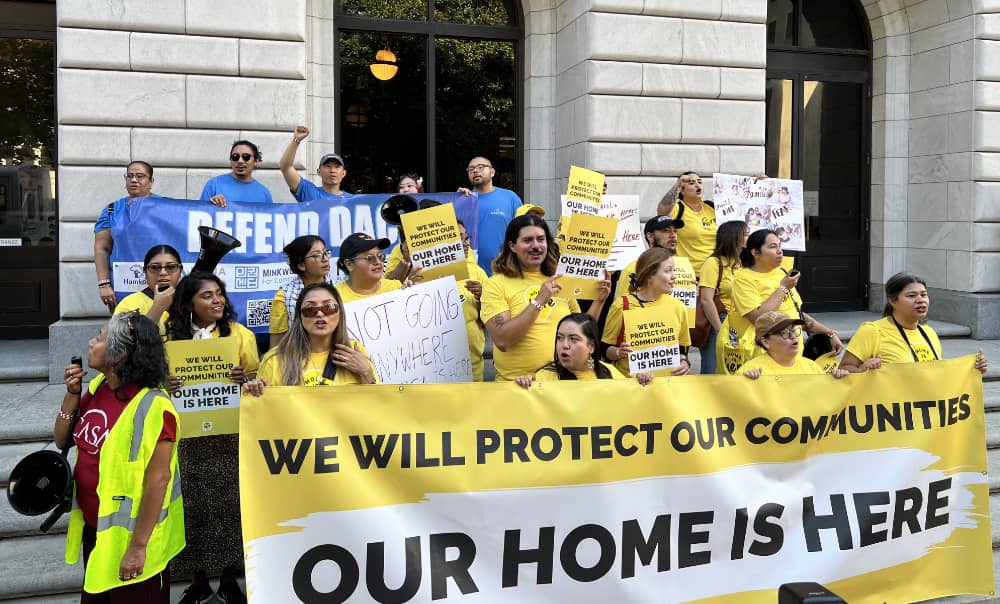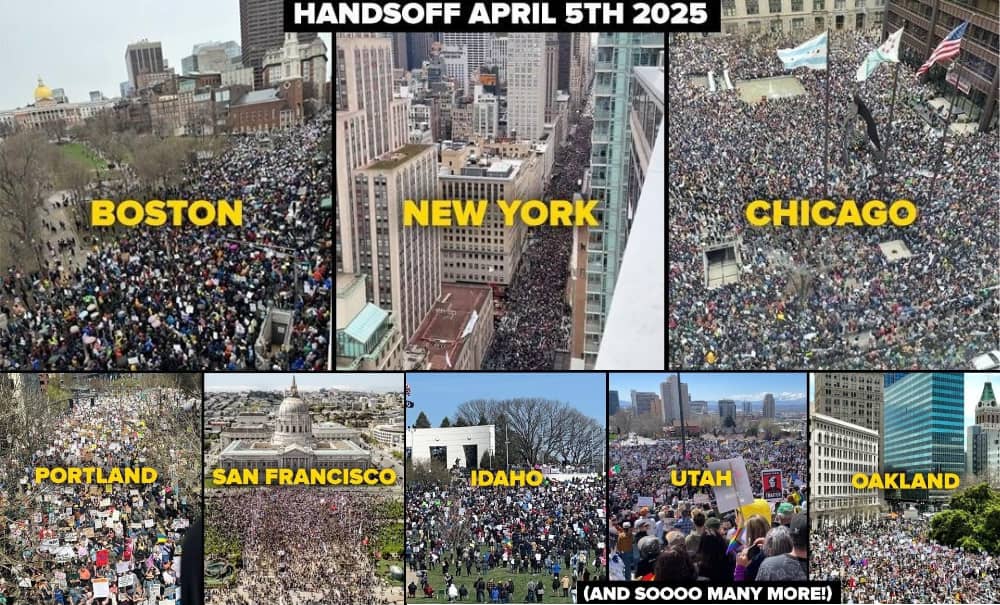
Dear friends,
The sidewalks are bursting with people, 37th Avenue in Jackson Heights is filled with immigrant workers, mothers, babies in strollers, fathers with sons and daughters in tow, grandmas, teenagers … It is May Day 2006, organized under the banner ‘A Day Without An Immigrant.’ Millions of immigrants and their allies take to the streets in massive demonstrations across the US with a show of strength and solidarity, standing up against legislation threatening undocumented communities and calling for comprehensive immigration reform.
Almost two decades later, it can feel hard to remember that moment of power and promise.
But May Day 2025 in New York saw immigrant justice movements in the streets again, this time arm in arm with movements for Palestine liberation, union labor, democratic process, and an end to billionaire oligarchy. As our first article highlights, both locally and nationally we see immigrant struggles actively making links with other mobilizations for freedom and justice. Collaborative politics in response to authoritarian threats is one strategic way forward.
Our second article turns to the small carceral island floating between Queens and the Bronx. We look at Rikers Island and efforts to overturn the hard-won victory of getting ICE out of Rikers. Mayor Adams and his new buddies at DHS are trying to re-open ICE deportation operations at Rikers. People are fighting back.
Newsletter highlights:
- Joining hands across issues: immigrant justice makes allies
- ICE returns to Rikers Isle? Not so fast
1. Allies at the Intersections
“The regime’s actions are designed to spread fear, break apart communities, and discourage public dissent. However, we have a clear message for the Trump regime: We refuse to be silent as our communities are criminalized and our freedoms are eroded.” —Solidarity Pledge (2025)
In recent months JHISN members have attended meetings hosted at DRUM (Desis Rising Up & Moving) headquarters near Diversity Plaza. The monthly event is the newest program that the South Asian and Indo-Caribbean immigrant rights group has created to bring allies in to join their work. Each meeting is built on the important work DRUM has forged over 25 years—upcoming discussions will have participants talking about what kinds of meaningful collaborative work can be done locally by a group of allies.
On April 18, the Elmhurst-based group Centro Corona hosted an event, open to the entire community, and shared the zine project they worked on in partnership with Red Canary Song (RCS):
“Despite organizing distinct communities, RCS and Centro Corona quickly learned we have common enemies, as well as a shared rage and grief about the injustice we experience in the world, and thus we are in deeply interlinked struggle.” —Bodies Not Borders zine (April 2025)
Over recent weeks, this collaborative approach has been seen at a larger scale through the massive national protests against the authoritarianism of the second Trump administration. JHISN walked next to DRUM and New York Communities for Change during Manhattan’s April 19 Earth Day March, where organizations fighting cuts in environmental protections marched with organizations confronting Trump’s anti-immigrant policies. The shared demands that day included:
- ICE Out of New York. Stop collaborating with ICE and protect our immigrant communities. New York must remain a sanctuary for all.
- New York Out of Fossil Fuels. Commit to a rapid, just transition to 100% renewable energy. No new fossil fuel infrastructure, and divest from fossil fuels now.
- Release Mahmoud Khalil, Rümeysa Öztürk, Mohsen Mahdawi and cease targeting student protesters.
- Release Kilmar Abrego Garcia and cease the targeting of all immigrant communities regardless of status.
Prior to Earth Day, on April 5, the national march named HandsOff 50501 (50 protests, 50 states, 1 movement) gathered together tens of thousands of people protesting multiple issues including demands to Resist Fascism, Free Mahmoud Khalil, Takedown Tesla, Protest for Democracy, March for the Arts, and Dance for Democracy. The organizers provided printable signs for people to demand the Republicans take their hands off our bodies, civil rights, union contracts, veteran services, scientific research, immigrants, free speech, LGBTQ+ rights, and more, and more, and more. We saw this again at the 50501-supported May Day Strong rallies across the nation demanding “a world where every family has housing, healthcare, fair wages, union protection, and safety—regardless of race, zip code, or immigration status.” Our local immigration advocacy group Make The Road NY was a critical participant in the NYC May Day Strong rally in Foley Square, and DRUM also had a vibrant contingent in the march from Foley to Battery Park.
This intersection of groups with different concerns and interests joining together is crucial for building power and will be key to changing the social narrative about immigration and immigrants. The importance of coming together was highlighted just three days before Trump’s return to office when a cohort of immigrant rights groups launched the solidarity pledge. Those who already signed the pledge are currently working on another action for Friday, May 23, and building support with other groups to create the event.
There are also plans for later this year, in November, when RaceForward will convene in St. Louis, Missouri. Their Just Narratives event will be the anchor to a Cultural Week of Action on Race and Democracy which includes elevating the voices of immigrants along with other groups. If they can do it in Missouri, and they can do it in Wisconsin, then in Jackson Heights we can definitely come together with local groups DRUM, Make the Road NY, Adhikaar, Centro Corona, NICE, Damayan, Asian Americans for Equality, Queens Neighborhood United, Voces Latinas, and Chhaya CDC to create our own intersectional action that combats the right-wing’s intersectionality of hate. You too can join groups together and Build the Resistance with us.
WHAT CAN WE DO?
- You and/or your organization can sign the Solidarity Pledge.
- Follow news about upcoming 50501 protests by joining the We the People Dissent substack newsletter.
- Participate with DRUM as an ally in the monthly planning meetings.
- Join the Build the Resistance call to action and sign up for a 1.5 hour webinar training.
2. At Rikers, a Battle for the Soul of the City
Rikers Island, our down-the-street neighbor, is a place where all the evils of New York City are concentrated. As City Council Member Tiffany Cabán declares, it is “a hellhole, a torture dungeon, a death chamber, a modern-day slave plantation, a site of relentless suffering and terror in every direction.” Perhaps it is fitting that Rikers is now the focus of a major struggle pitting New York as a sanctuary city against the Trump regime’s program of mass deportation.
It was Mayor Bloomberg who first approved the establishment of an ICE office at Rikers, in 2003. Although he often bragged about New York as a city of immigrants, Bloomberg was a supporter of the Criminal Alien Program (CAP), set up to deport immigrant arrestees. CAP claims to focus on immigrants with serious criminal backgrounds. But once embedded in jails and prisons, the program simply deports as many incarcerated immigrants as it can. The American Immigration Council notes: “DHS statistics show that a large percentage of immigrants apprehended under CAP are not criminals at all. An October 2009 DHS report found that 57 percent of immigrants identified through CAP in fiscal 2009 had no criminal convictions, up from 53 percent in fiscal 2008.”
At Rikers, The NY Post reports that “up to 15 agents worked closely with Department of Corrections staff, and could monitor inmates and issue detainer orders for [undocumented] immigrants on their radar.” As described by the ACLU, the results of CAP back then were devastating:
“Between 2004 and 2009, more than 13,000 inmates at Rikers Island were placed into deportation proceedings as a result of the Criminal Alien Program. According to numerous reports, inmates often don’t know that they are speaking with federal agents, understand that they could be placed into deportation proceedings as a result of the information they share, or realize that they may refuse to consent to an interview.”
A fierce 5-year campaign by the ICE Out of Rikers coalition, led by Make the Road New York, succeeded in convincing the City Council and Mayor de Blasio to limit ICE’s access to inmates, and ultimately to adopt legislation removing ICE from the island. Now, exactly ten years later, the Adams administration is trying to get ICE back in, using a legally questionable executive order. The carefully written order promises that ICE will not “engage in civil immigration enforcement” at Rikers—something explicitly forbidden by NYC sanctuary law—but will merely “assist” the Department of Correction in various “criminal investigations.”
The City Council quickly filed suit against the mayor’s executive order, charging that it is a transparent attempt to undermine the law by giving ICE access to information about immigrants’ status and location. They also allege that it is part of a “corrupt bargain” that Adams made with the Trump administration to get federal indictments against him dismissed. The Council notes that the mayor announced his plan to invite ICE to Rikers the same day he met with Trump’s border chief, Thomas Homan. Council Speaker Adrienne Adams remarked that “we are filing this lawsuit to halt his illegal order that he shamelessly previewed on the Fox News couch with Tom Homan.” Daniel Kornstein, attorney for the Council, promised to subpoena Homan to make him testify about the deal with Adams.
The Council”s lawsuit has kept ICE out of Rikers so far. At a hearing on April 25, Manhattan Supreme Court Judge Mary Rosado issued a restraining order preventing any changes until a formal hearing can be scheduled to resolve the issue.
Homan and Mayor Adams surely know that the vast majority of those held in city jails are not there because they were convicted of a serious offense. For instance, as of Friday, April 27, out of 7,345 people incarcerated by NYC (mostly at Rikers), fewer than 800 have been found guilty and are actually serving sentences. 5,362 inmates are in pretrial detention. It is a deep injustice that many of these people find themselves imprisoned for years under terrifying conditions simply because their families can’t afford bail.
Under current law, right or wrong, the city already cooperates with ICE to facilitate the deportation of undocumented immigrants convicted of “violent or serious felonies”—177 offenses in all. But hundreds of people are being held at Rikers on suspicion of illegal drug possession and other nonviolent offenses. Crucially, many current inmates will be found innocent. Yet for Eric Adams, “innocent until proven guilty” doesn’t apply to non-citizens. He thinks that simply being suspected of an offense makes a person automatically a criminal—especially if they are a working class immigrant.
“City law prohibits ICE from operating on Rikers for good reason. When ICE had access to the jail, they used it to surveil, intimidate, and conduct uncounseled interviews in an inherently coercive setting; allowing them to extract admissions about nationality and immigration status, and then using those statements to justify detention and deportation …. That is why New York City passed sanctuary laws—not to grant special privileges, but to impose basic legal protections of due process in a system that otherwise offers none.” —Bronx Defenders
WHAT CAN WE DO?
- Consider donating to a bail fund to help people await trial with their families, in dignity.
- Help the Bronx Defenders represent low-income people in the justice system.
In solidarity and with collective care,
Jackson Heights Immigrant Solidarity Network (JHISN)
Follow @JHSolidarity on Facebook and Twitter and share this newsletter with friends, families, neighbors, networks, and colleagues so they can subscribe and receive news from JHISN.

